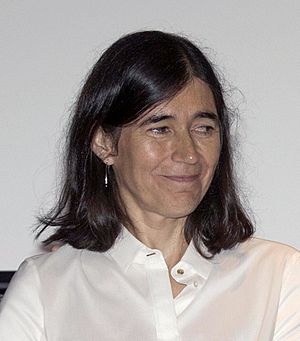María Blasco Marhuenda facts for kids
Quick facts for kids
María Blasco
|
|
|---|---|
 |
|
| Born |
María Antonia Blasco Marhuenda
1965 (age 59–60) |
| Nationality | Spanish |
| Alma mater | Universidad de Valencia, BSc Universidad Autónoma de Madrid, PhD |
| Awards | EMBO Gold Medal (2004) |
| Scientific career | |
| Fields | Molecular biology |
| Institutions | Spanish National Cancer Research Centre |
María Antonia Blasco Marhuenda (born 1965), known as María Blasco, is a Spanish scientist who studies molecular biology. She was the director of the Spanish National Cancer Research Centre (CNIO), a very important research center, from June 2011 until January 2025.
Contents
About María Blasco
María Blasco was born in Spain in 1965. She earned her PhD degree in 1993. She did her research at the Centro de Biología Molecular Severo Ochoa with her supervisor, Margarita Salas.
Early Career and Research
In 1993, María Blasco moved to New York, USA. She joined the Cold Spring Harbor Laboratory as a Postdoctoral Fellow. She worked with Carol W. Greider, who later won a Nobel Prize in 2009.
In 1997, she came back to Spain. She started her own research group at the Centro Nacional de Biotecnología in Madrid. In 2003, she joined the Centro Nacional de Investigaciones Oncológicas (CNIO). There, she became the Director of the Molecular Oncology Programme. She also led the Telomeres and Telomerase Group.
In 2005, she became the Vice-Director of Basic Research at CNIO. In 2011, she was chosen to be the Director of CNIO. Her time as director ended in January 2025. In 2010, María Blasco also helped start a company called Life Length. This company works with biotechnology.
What María Blasco Researches
María Blasco's research focuses on telomeres and telomerase. Telomeres are like caps at the ends of our DNA. They protect our chromosomes. Telomerase is an enzyme that helps keep telomeres long. Her work helps us understand aging and cancer.
Key Discoveries
- She found the main parts of telomerase in mice. She also created the first mouse without telomerase.
- She made the first mouse that had more telomerase in its body tissues.
- She discovered that telomeres have special marks. These marks are linked to how cells work.
- She found small pieces of RNA near telomeres. These can stop telomerase. Their levels change in cancer.
- She showed that telomerase activity and telomere length are important for how well stem cells can repair and renew tissues.
- She found that the longest telomeres are always in areas where adult stem cells are found.
- Her team showed that having more telomerase can slow down aging in mice. It also made them live longer.
- She discovered that telomeres can become "younger" after cells are reprogrammed.
- She found out why short telomeres can stop cells from being reprogrammed.
- She discovered that a protein called TRF1 can help prevent both cancer and aging.
Professional Journey
- 2011–2025: Director of the Spanish National Cancer Research Centre (CNIO)
- 2005–2011: Vice-Director of Basic Research (CNIO)
- 2003–2011: Director, Molecular Oncology Program (CNIO)
- 2003–present: Head, Telomeres and Telomerase Group (CNIO)
- 1997–2003: Staff Investigator, National Center of Biotechnology, Madrid, Spain
- 1993–1996: Postdoctoral Fellow, Cold Spring Harbor Laboratory, New York, USA. (Supervisor: Dr. Carol W. Greider)
- 1992–1993: Postdoctoral Fellow, Center of Molecular Biology, Madrid, Spain. (Supervisor: Dr. Margarita Salas)
- 1989–1992: Graduate Fellow, Center of Molecular Biology, Madrid, Spain. (Supervisor: Dr. Margarita Salas)
Awards and Recognitions
María Blasco has received many awards for her important scientific work.
- 2021: Progressive Women of Retirement Award
- 2019: Optimist Award Committed to Science
- 2018: Included in the Periodic Table of Scientists. This was to celebrate the 150th anniversary of the Periodic Table.
- 2017: Distinction from the Generalitat Valenciana for Scientific Merit
- 2016: Women to Follow Award
- 2013: Fellow of the Royal Academy of Pharmacy of Spain
- 2012: Member of the Scientific Board of the AXA Research Fund
- 2012: Member of the Scientific Board of the Vall d’Hebron Institut de Recerca (VHIR)
- 2012: Member of the Board of Trustees and President of the External Advisory Board of the Spanish National Centre for Research on Ageing (CNIE)
- 2012: "Honorary Ambassador of the Brand Spain-2013" by the Spanish Ministry of Foreign Affairs
- 2010: National Research Award Santiago Ramón y Cajal. This is a very high honor in Spain for research.
- 2010: Lilly Foundation Preclinical Research Award
- 2009: Prize "Alberto Sols" for Excellence in Research
- 2008: Körber European Science Award
- 2007: Rey Jaime I Prize for Basic Research
- 2005: Carmen and Severo Ochoa Award in Molecular Biology
- 2004: EMBO Gold Medal
- 2003: Josef Steiner Cancer Research Award
- 2002: Early Career Award from the European Life Sciences Organization (ELSO)
- 2002: "Young Cancer Researcher Award" from the European Association for Cancer Research (EACR)
- 2000: FEBS Anniversary Prize
- 1999: II Spanish National Oncology Award
See also
 In Spanish: María Blasco Marhuenda para niños
In Spanish: María Blasco Marhuenda para niños

